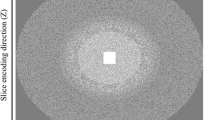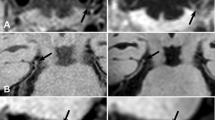Abstract
Objectives
To compare visualization of joint intracranial and carotid vessel walls between 5× compressed sensing accelerated three-dimensional DANTE-SPACE sequence (CS VWI) acquired in 5 min and the same sequence accelerated by 2.7× parallel imaging (PI VWI) which takes 9–10 min currently.
Methods
Following institutional review board approval and informed consent, 28 subjects including 20 stroke patients underwent PI and CS VWI examinations with an acquired spatial resolution of isotropic 0.55 mm and joint coverage of intracranial and carotid arteries. Quantitative wall thickness measurements of CS VWI and PI VWI were compared on healthy volunteers and patients with wall thickening respectively. Subjective wall visualizations of the two VWI methods on patients were scored by two radiologists blindly and independently using a 4-point scale followed by inter-rater reproducibility analysis.
Results
Linear regression analysis of wall thickness measurements showed excellent agreement between CS VWI and PI VWI in both healthy volunteers (r = 0.99) and stroke patients with wall thickening (r = 0.99). Subjective wall visualization score of CS VWI was slightly lower than PI VWI (3.13 ± 0.41 vs. 3.31 ± 0.79) but still had good diagnostic quality (> 3 based on a 4-point scale). The two radiologists’ scores agreed excellently, evidenced by the intraclass correlation coefficient (ICC) values being higher than 0.75 (p < 0.001).
Conclusions
Compressed sensing expedients joint intracranial and carotid VWI acquired at an isotropic resolution of 0.55 mm in 5 min without compromising quantitative vessel wall thickness measurement or diagnostic wall visualization.
Key Points
• CS VWI facilitates comprehensive visualization of intracranial and carotid vessel walls at an acquired isotropic resolution of 0.55 mm in a single 5-min scan.
• CS VWI affords comparable vessel wall visualization and morphology measurement as PI VWI with a shortened acquisition time by 45%.
• CS VWI alleviates the intensive trade-off between imaging resolution and scan time, and benefits the scan efficiency, motion robustness, and patient tolerance of high-resolution joint intracranial and carotid VWI.





Similar content being viewed by others
Abbreviations
- 2D:
-
Two-dimensional
- 3D:
-
Three-dimensional
- BA:
-
Basilar artery
- CCA:
-
Common carotid artery
- CE:
-
Contrast enhanced
- CS:
-
Compressed sensing
- DANTE:
-
Delay alternating with nutation for tailored excitation
- ECA:
-
Extracranial carotid artery
- ICA:
-
Internal carotid artery
- MCA:
-
Middle cerebral artery
- MPR:
-
Multi-planar reconstruction
- MRA:
-
Magnetic resonance angiography
- PI:
-
Parallel imaging
- POCS:
-
Projection onto convex sets
- SPACE:
-
Sampling perfection with application of optimized contrast using different flip angle evolution
- SPIRiT:
-
Iterative self-consistent parallel imaging reconstruction
- VA:
-
Vertebral artery
- VWI:
-
Vessel wall imaging
References
Qureshi A, Caplan L (2014) Intracranial atherosclerosis. Lancet 383:984–998
Boussel L, Arora S, Rapp J et al (2009) Atherosclerotic plaque progression in carotid arteries: monitoring with high-spatial-resolution MR imaging-multicenter trial. Radiology 252:789–796
Mandell DM, Mossa-Basha M, Qiao Y et al (2017) Intracranial vessel wall MRI: principles and expert consensus recommendations of the American Society of Neuroradiology. AJNR Am J Neuroradiol 38:218–229
Dieleman N, van der Kolk AG, Zwanenburg JJM et al (2014) Imaging intracranial vessel wall pathology with magnetic resonance imaging: current prospects and future directions. Circulation 130:192–201
Choi YJ, Jung SC, Lee DH (2015) Vessel wall imaging of the intracranial and cervical carotid arteries. J Stroke 17:238–255
Lindenholz A, van der Kolk AG, Zwanenburg JJM, Hendrikse J (2018) The use and pitfalls of intracranial vessel wall imaging: how we do it. Radiology 286:12–28
Saba L, Yuan C, Hatsukami TS et al (2018) Carotid artery wall imaging: perspective and guidelines from the ASNR Vessel Wall Imaging Study Group and expert consensus recommendations of the American Society of Neuroradiology. AJNR Am J Neuroradiol 39:9–31
Qiao Y, Steinman DA, Qin Q et al (2011) Intracranial arterial wall imaging using three-dimensional high isotropic resolution black blood MRI at 3.0 tesla. J Magn Reson Imaging 34:22–30
Zhang L, Zhang N, Wu J et al (2015) High resolution three dimensional intracranial arterial wall imaging at 3T using T1 weighted SPACE. Magn Reson Imaging 33:1026–1034
Fan Z, Yang Q, Deng Z et al (2017) Whole-brain intracranial vessel wall imaging at 3 tesla using cerebrospinal fluid-attenuated T1-weighted 3D turbo spin echo. Magn Reson Med 77:1142–1150
Balu N, Yarnykh VL, Chu B, Wang J, Hatsukami T, Yuan C (2011) Carotid plaque assessment using fast 3D isotropic resolution black-blood MRI. Magn Reson Med 65:627–637
Fan Z, Zhang Z, Chung YC et al (2010) Carotid arterial Wall MRI at 3T using 3D variable-flip-angle turbo spin-echo (TSE) with flow-sensitive dephasing (FSD). J Magn Reson Imaging 31:645–654
Li L, Chai J, Biasiolli L et al (2014) Black-blood multicontrast imaging of carotid arteries with DANTE-prepared 2D and 3D MR imaging. Radiology 273:560–569
Edjlali M, Roca P, Rabrait C, Naggara O, Oppenheim C (2014) 3D fast spin-echo T1 black-blood imaging for the diagnosis of cervical artery dissection. AJNR Am J Neuroradiol 34:103–106
Cuvinciuc V, Viallon M, Momjian-Mayor I, (2013) 3D fat-saturated T1 SPACE sequence for the diagnosis of cervical artery dissection. Neuroradiology 55:595–602
Han M, Rim NJ, Lee JS, Kim SY, Choi JW (2014) Feasibility of high-resolution MR imaging for the diagnosis of intracranial vertebrobasilar artery dissection. Eur Radiol 24:3017–3024
Xu Y, Yuan C, Zhou Z et al (2016) Co-existing intracranial and extracranial carotid artery atherosclerotic plaques and recurrent stroke risk: a three-dimensional multicontrast cardiovascular magnetic resonance study. J Cardiovasc Magn Reson 18:90–97
Zhou Z, Li R, Zhao X et al (2015) Evaluation of 3D multi-contrast joint intra- and extracranial vessel wall cardiovascular magnetic resonance. J Cardiovasc Magn Reson 17:41–51
Xu Y, Li D, Yuan C et al (2018) Association of severity between carotid and intracranial artery atherosclerosis. Ann Clin Transl Neurol 5:843–849
Xie Y, Yang Q, Xie G, Pang J, Fan Z, Li D (2016) Improved black-blood imaging using DANTE-SPACE for simultaneous carotid and intracranial vessel wall evaluation. Magn Reson Med 75:2286–2294
Hu X, Li Y, Zhang L, Zhang X, Liu X, Chung YC (2016) A 32-channel coil system for MR vessel wall imaging of intracranial and extracranial arteries at 3T. Magn Reson Imaging 36:86–92
Zhang L, Zhang N, Wu J, Liu X, Chung YC (2017) High resolution simultaneous imaging of intracranial and extracranial arterial wall with improved cerebrospinal fluid suppression. Magn Reson Imaging 44:65–71
Murphy M, Alley M, Demmel J, Keutzer K, Vasanawala S, Lustig M (2012) Fast l(1)-SPIRiT compressed sensing parallel imaging MRI: scalable parallel implementation and clinically feasible runtime. IEEE Trans Med Imaging 31:1250–1262
Zhang T, Chowdhury S, Lustig M et al (2014) Clinical performance of contrast enhanced abdominal pediatric MRI with fast combined parallel imaging compressed sensing reconstruction. J Magn Reson Imaging 40:13–25
Hansen SM, Sørensen TS (2013) Gadgetron: an open source framework for medical image reconstruction. Magn Reson Med 69:1768–1776
Zhang N, Fan Z, Deng Z et al (2018) 3D whole-brain vessel wall cardiovascular magnetic resonance imaging: a study on the reliability in the quantification of intracranial vessel dimensions. J Cardiovasc Magn Reson 20:39–50
Okuchi S, Fushimi Y, Okada T et al (2019) Visualization of carotid vessel wall and atherosclerotic plaque: T1-SPACE vs. compressed sensing T1-SPACE. Eur Radiol 29:1452–1459
Zhu C, Tian B, Chen L et al (2017) Accelerated whole brain intracranial vessel wall imaging using black blood fast spin echo with compressed sensing (CS-SPACE). MAGMA 31:457–467
Li L, Miller KL, Jezzard P (2012) DANTE-prepared pulse trains: a novel approach to motion-sensitized and motion-suppressed quantitative magnetic resonance imaging. Magn Reson Med 68:1423–1438
Wang J, Helle M, Zhou Z, Börnert P, Hatsukami TS, Yuan C (2016) Joint blood and cerebrospinal fluid suppression for intracranial vessel wall MRI. Magn Reson Med 75:831–838
Xue H, Inati S, Sørensen TS, Kellman P, Hansen MS (2015) Distributed MRI reconstruction using Gadgetron-based cloud computing. Magn Reson Med 73:1015–1025
Qiao Y, Zeiler SR, Mirbagheri S et al (2014) Intracranial plaque enhancement in patients with cerebrovascular events on high-spatial-resolution MR images. Radiology 271:534–542
Mossa-Basha M, Hwang WD, Havenon AD et al (2015) Multicontrast high-resolution vessel wall magnetic resonance imaging and its value in differentiating intracranial vasculopathic proces. Stroke 46:1567–1573
Lustig M, Donoho D, Pauly JM (2007) Sparse MRI: the application of compressed sensing for rapid MR imaging. Magn Reson Med 58:1182–1195
Funding
This study has received funding from the State Key Program of National Natural Science Foundation of China (Grant No. 81830056), the National Natural Science Foundation of China (Grant No. 81801691), and the Natural Science Foundation of Guangdong Province (Grant No. 2018A030313204).
Author information
Authors and Affiliations
Corresponding author
Ethics declarations
Guarantor
The scientific guarantor of this publication is Xin Liu, MD.
Conflict of interest
Dr. Yiu-cho Chung is an employee of Siemens Healthcare Pte. Ltd., Singapore. Other authors of this manuscript declare no relationships with any companies, whose products or services may be related to the subject matter of the article.
Statistics and biometry
No complex statistical methods were necessary for this paper.
Informed consent
Written informed consent was obtained from all subjects (patients) in this study.
Ethical approval
Institutional Review Board approval was obtained.
Methodology
• retrospective
• cross-sectional
• performed at one institution
Additional information
Publisher’s note
Springer Nature remains neutral with regard to jurisdictional claims in published maps and institutional affiliations.
Rights and permissions
About this article
Cite this article
Jia, S., Zhang, L., Ren, L. et al. Joint intracranial and carotid vessel wall imaging in 5 minutes using compressed sensing accelerated DANTE-SPACE. Eur Radiol 30, 119–127 (2020). https://doi.org/10.1007/s00330-019-06366-7
Received:
Revised:
Accepted:
Published:
Issue Date:
DOI: https://doi.org/10.1007/s00330-019-06366-7




